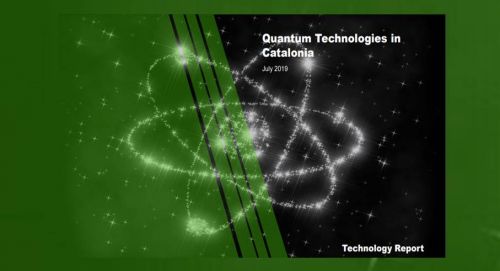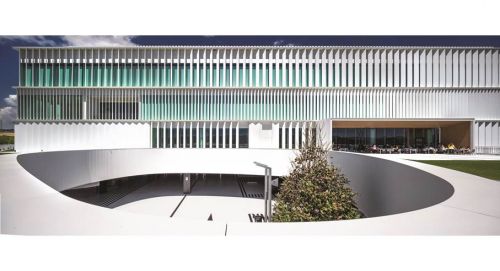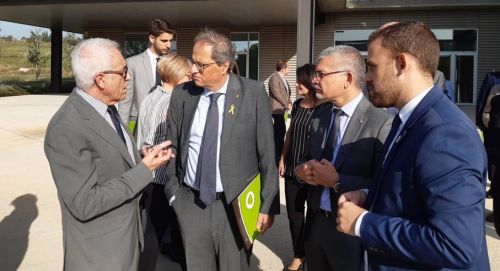News

03/01/2020
AllRead MLT, a success story originated from the PRUAB’s Ideas Generation Program
AllRead MLT, a success story originated from the PRUAB’s Ideas Generation Program
The AllRead MLT (AllRead Machine Learning Technologies) project started in 2016 from the Ideas Generation Program carried out by PRUAB, the UAB university research park, and sponsored by the Barcelona Synchrotron Park (BSP). This annual program is based on the collection of local companies’ technological challenges that are submitted to the UAB scientific community: every year, this program aims at offering companies the benefit of the UAB researchers’ wealth of creativity to get proposals for their innovation projects.
AllRead MLT is now a spin-off company from the Computer Vision Centre (CVC-UAB) located at the UAB university campus (CVC-UAB). This company is specialized in detecting text in images and digitizing them. Its objective is to bring to the market its own technology, based on deep learning, which speeds up, for example, the identification and monitoring of containers in ports and airports.
Jointly to Erudito, AllRead MLT was one of the two finalist start-up companies of the last Bbooster Week held in Valencia on December 2-4. During this investment event organized by Bbooster Ventures to select and invest in start-ups, a € 100,000 convertible loan was awarded to AllRead MLT.
The goal of the startup is to close new rounds of funding during 2020 and to go on developing its product already successfully tested during different pilot tests with the Port of Barcelona and other companies from different sectors, such as Suez, Comsa and International Airlines Group.
Good luck!
AllRead MLT is now a spin-off company from the Computer Vision Centre (CVC-UAB) located at the UAB university campus (CVC-UAB). This company is specialized in detecting text in images and digitizing them. Its objective is to bring to the market its own technology, based on deep learning, which speeds up, for example, the identification and monitoring of containers in ports and airports.
Jointly to Erudito, AllRead MLT was one of the two finalist start-up companies of the last Bbooster Week held in Valencia on December 2-4. During this investment event organized by Bbooster Ventures to select and invest in start-ups, a € 100,000 convertible loan was awarded to AllRead MLT.
The goal of the startup is to close new rounds of funding during 2020 and to go on developing its product already successfully tested during different pilot tests with the Port of Barcelona and other companies from different sectors, such as Suez, Comsa and International Airlines Group.
Good luck!

06/11/2019
SENER, a top-class aerospace systems provider
SENER, a top-class aerospace systems provider
SENER Aerospace, division of the multinational engineering and technology group SENER (2,300 people in 18 countries with Catalan headquarters set up in the Barcelona Synchrotron Park with a strong activity in the aerospace sector), experienced a rich October with several interesting news. Four of them are briefly explained below:
Good take-offs!
- SENER Aerospace delivered the antenna feeds of all Galaxy-30 satellite reflectors, a commercial communication satellite from the Northrop Grumman Company.
- SENER Aerospace and CATEC developed a 3D-printed metal antenna for the European Space Agency's PROBA-3 space mission, one of the first space antennas in the world developed using this 3D printing technology (SENER Aerospace is the main contractor for the PROBA-3 mission).
- SENER Aerospace has successfully completed the delivery of the nominal version of the Attitude and Orbit Control System (AOCS) for the Euclid satellite, an ESA cosmology mission aimed at investigating the nature of dark matter and dark energy (Euclid includes a 1.2 m diameter telescope).
- Finally, SENER Aerospace delivered the flight model of the Umbilical Release Mechanism for the Rosalind Franklin Rover of the ExoMars 2020 ESA mission that will start its journey to the red planet in next July.
Good take-offs!

29/10/2019
The ICN2 research center is involved in the quantum revolution
The ICN2 research center is involved in the quantum revolution
We are living through a quantum revolution based on technologies that use the very little intuitive behavior of matter and light and its interactions at the scale of atoms and photons. Such a behavior is well described by quantum mechanics, a branch a physics born at the beginning of the 20th century.
Two fields are specially impacted by this revolution: communication and computation. Regarding the first one, quantum technology already allows fully secure communications. In computation, things are not so advanced but the uniqueness of the individual behaviors of atoms can allow new ways of computing and thus offer phenomenal powers of calculation, even impossible in a classical way.
In this context, the Catalan government agency for business competitiveness ACCIÓ recently issued a report jointly written with the Institute of Photonic Sciences (ICFO) on the potential of Catalonia in this sector. Among the 6 public research centers pointed out in this document, 3 are on the UAB campus, the key partner of the Barcelona Synchrotron Park: the National Center for Microelectronics (CNM), the Institute of High Energy Physics (IFAE) and the Catalan Institute of Nanoscience and Nanotechnology (ICN2).
Regarding ICN2, the research center recently announced that it has expanded its collaboration with the global network of Microsoft Quantum Labs in furtherance of the goal of developing a scalable quantum computer. The ICN2 laboratories will provide atomic-scale measurements, analysis, and modeling of new materials.
The ICN2 Advanced Electron Nanoscopy Group, led by ICREA Prof. Jordi Arbiol, will provide its expertise in electron microscopy and related spectroscopies to perform measurements and analysis of the complex structure and physical properties of a new kind of nanowires that could be used in quantum computers.
Two fields are specially impacted by this revolution: communication and computation. Regarding the first one, quantum technology already allows fully secure communications. In computation, things are not so advanced but the uniqueness of the individual behaviors of atoms can allow new ways of computing and thus offer phenomenal powers of calculation, even impossible in a classical way.
In this context, the Catalan government agency for business competitiveness ACCIÓ recently issued a report jointly written with the Institute of Photonic Sciences (ICFO) on the potential of Catalonia in this sector. Among the 6 public research centers pointed out in this document, 3 are on the UAB campus, the key partner of the Barcelona Synchrotron Park: the National Center for Microelectronics (CNM), the Institute of High Energy Physics (IFAE) and the Catalan Institute of Nanoscience and Nanotechnology (ICN2).
Regarding ICN2, the research center recently announced that it has expanded its collaboration with the global network of Microsoft Quantum Labs in furtherance of the goal of developing a scalable quantum computer. The ICN2 laboratories will provide atomic-scale measurements, analysis, and modeling of new materials.
The ICN2 Advanced Electron Nanoscopy Group, led by ICREA Prof. Jordi Arbiol, will provide its expertise in electron microscopy and related spectroscopies to perform measurements and analysis of the complex structure and physical properties of a new kind of nanowires that could be used in quantum computers.

21/10/2019
Stradivarius keeps growing
Stradivarius keeps growing
Last results show that Stradivarius, the young fashion brand company headquartered in the Barcelona Synchrotron Park, is the Inditex’s branch that has grown the most during the first six months of that year (Inditex is the world's largest fashion retailers with Massimo Dutti, Bershka, Stradivarius, Oysho, Pull&Bear, Uterqüe and Zara).
According to the figures published by the specialized digital magazine Modaes.es in an article issued last month, Stradivarius incomes grew by 12.5% (to reach 776 million euros) between January and June, the only double-digit growth in Inditex, jointly with Uterqüe (12%).
Next November 12 will correspond to the 10th year of the acquisition of Stradivarius by Inditex. During this decade, the company with the treble clef, which was created by the Triquell family, has increased significantly: from 100 shops to more than 1,000, from € 70 million incomes to 1.5 billion, from 7 countries to almost all Northern Hemisphere.
Born in Sant Quirze in the mid-80s´, the company installed its new headquarters few kilometers from there: since April 2017, Stradivarius occupies a building designed by Batlle&Roig (see photo) built in our park: the company wanted a place near Barcelona, well connected to the city, a place that enhances the new building and that offers an inspiring setting for the designers and all the team that make Stradivarius the well-known creative international clothing fashion brand.
According to the figures published by the specialized digital magazine Modaes.es in an article issued last month, Stradivarius incomes grew by 12.5% (to reach 776 million euros) between January and June, the only double-digit growth in Inditex, jointly with Uterqüe (12%).
Next November 12 will correspond to the 10th year of the acquisition of Stradivarius by Inditex. During this decade, the company with the treble clef, which was created by the Triquell family, has increased significantly: from 100 shops to more than 1,000, from € 70 million incomes to 1.5 billion, from 7 countries to almost all Northern Hemisphere.
Born in Sant Quirze in the mid-80s´, the company installed its new headquarters few kilometers from there: since April 2017, Stradivarius occupies a building designed by Batlle&Roig (see photo) built in our park: the company wanted a place near Barcelona, well connected to the city, a place that enhances the new building and that offers an inspiring setting for the designers and all the team that make Stradivarius the well-known creative international clothing fashion brand.

19/09/2019
The president of Catalonia visited the Barcelona Synchrotron Park
The president of Catalonia visited the Barcelona Synchrotron Park
“A country structure”: Barcelona Synchrotron Park director Pere Solà used that phrase to summarize the role of the park to the president of Catalonia Quim Torra during his visit on September 18.
The director explained the three missions of the Park: hosting innovative companies, building a new neighbourhood and protecting biodiversity. He particularly mentioned the future 30,000 jobs that will be generated, the 5,700 apartments (social protection floor for 47% of them) and the green corridor.
Regarding the new urban master plan about to enter the public information phase, Pere Solà pointed out, among other aspects, the future public transportation network and the original action plan in urban planning and health.
The president could have an accurate picture of this reality travelling by bus the 400 hectares of the park. He concluded his visit at Alba synchrotron where director Caterina Biscari took him to discover this iconic infrastructure, the largest science facility in the Iberian Peninsula.
At the end of the visit, the President announced that the government will invest a total of 25 million euros in the Alba Synchrotron: 20 to install four new beam lines that will be operational between 2020 and 2023, and 5 million euros to build the Advanced Microscopy Center.
The director explained the three missions of the Park: hosting innovative companies, building a new neighbourhood and protecting biodiversity. He particularly mentioned the future 30,000 jobs that will be generated, the 5,700 apartments (social protection floor for 47% of them) and the green corridor.
Regarding the new urban master plan about to enter the public information phase, Pere Solà pointed out, among other aspects, the future public transportation network and the original action plan in urban planning and health.
The president could have an accurate picture of this reality travelling by bus the 400 hectares of the park. He concluded his visit at Alba synchrotron where director Caterina Biscari took him to discover this iconic infrastructure, the largest science facility in the Iberian Peninsula.
At the end of the visit, the President announced that the government will invest a total of 25 million euros in the Alba Synchrotron: 20 to install four new beam lines that will be operational between 2020 and 2023, and 5 million euros to build the Advanced Microscopy Center.

12/09/2019
Alba, a tool to tackle challenges in the fields of renewable energy production and fight against air pollution
Alba, a tool to tackle challenges in the fields of renewable energy production and fight against air pollution
Perovskites materials are promising candidates for next generation solar cells. However, their use is still limited by their instability within ambient conditions. An international team of scientists, led by a group from KU Leuven in Belgium, have shone a light on this problem developing a new method to stabilize the black form introducing strain into the perovskite thin film using the glass substrate on which it sits. Synchrotron-based techniques at the ALBA Synchrotron (NCD-SWEET beam line) and the European Synchrotron Radiation Facility in Grenoble (France) were crucial for obtaining these results, published in July in the prestigious magazine Science.
Another recently published article tackles the problem of pollution sensors. The increasing emissions of volatile organic compounds (VOCs) and their resulting impact on air and water quality has become one of the major environmental concerns of our age. Researchers at IMDEA Nanociencia (Madrid) have developed an easily-made coordination polymer as an acetonitrile chemical sensor with a simple electro-optical readout (acetonitrile is primary used as an organic solvent). The studies have been carried out with synchrotron light techniques at the XALOC beam line in ALBA and also at the Advanced Light Source in Berkeley (USA).
These research works are two recent examples, among others, of Alba’s contribution to tackle key society challenges. Another way to improve society consists in giving companies answers to their technology challenges. In that sense, Alba regularly invites delegations to discover how a synchrotron can help solve industrial issues. The last meeting was in July with a delegation of the Spanish Society of Cosmetic Chemists (SEQC) that could discover the different applications Alba offers in cosmetics such as skin structural investigations, analysis of skin penetration of compounds or structural characterizations of end cosmetic products.
Another recently published article tackles the problem of pollution sensors. The increasing emissions of volatile organic compounds (VOCs) and their resulting impact on air and water quality has become one of the major environmental concerns of our age. Researchers at IMDEA Nanociencia (Madrid) have developed an easily-made coordination polymer as an acetonitrile chemical sensor with a simple electro-optical readout (acetonitrile is primary used as an organic solvent). The studies have been carried out with synchrotron light techniques at the XALOC beam line in ALBA and also at the Advanced Light Source in Berkeley (USA).
These research works are two recent examples, among others, of Alba’s contribution to tackle key society challenges. Another way to improve society consists in giving companies answers to their technology challenges. In that sense, Alba regularly invites delegations to discover how a synchrotron can help solve industrial issues. The last meeting was in July with a delegation of the Spanish Society of Cosmetic Chemists (SEQC) that could discover the different applications Alba offers in cosmetics such as skin structural investigations, analysis of skin penetration of compounds or structural characterizations of end cosmetic products.









